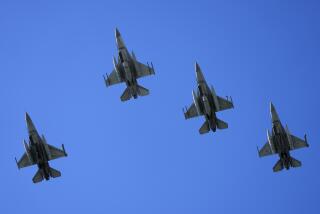U.S. Seeks Syria’s Help in Mideast
John Broder’s article, “Air Force Poised in Gulf With Formidable Options” (Aug. 24), highlights many of the resources the Air Force would be called upon to employ if the gulf crisis cannot be peacefully resolved. Unfortunately, his use of categorizations like “wreaking damage” and “push-button” weapons could cause a reader to come away with a disjointed or piecemeal appreciation of an air campaign’s intended purpose.
This nation’s successful pursuit of technological excellence has given our joint forces several decided advantages, one of the greatest of these being an Air Force with global reach. Its use is calculated to achieve political and military objectives with the minimum loss of human life.
Air options are refinements of military campaigning that capitalize on established principals of war. As such, they are developed by strategists rather than enthusiasts, and their goal is to exploit enemy vulnerabilities rather than to employ an array of push-button weapons.
If U.S. military force is required in the Middle East, we would be expected to execute a joint campaign that strategically influences Hussein. To be successful it will have to overcome several complex geographical, cultural and timing considerations. In such a campaign, the capabilities and flexibility inherent in air power’s speed, range, precision and lethality would certainly be decisive.
THOMAS M. KEARNEY
Lt. Col, USAF
Air Force Secretary’s Staff Group
Washington, D.C.
More to Read
Sign up for Essential California
The most important California stories and recommendations in your inbox every morning.
You may occasionally receive promotional content from the Los Angeles Times.










